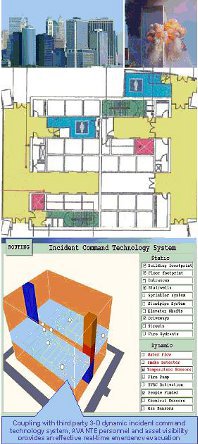AVANTE PERSONNEL and ASSETS VISIBILITY SYSTEM (AVANTE PAVS-300) PROVIDES LOCAL AND CAMPUS-WIDE ALERTS AND REAL-TIME LOCATING OF PERSONNEL FOR SAFTEY AND EMERGENCY MANAGEMENT
The challenges facing campus-based safety and security system have been highlighted in the 2006 Virginia Technology incident:
- It is difficult to broadcast special notices or alerts to all students.
- Cellular network of phones and pagers are only useful if numbers (IP addresses) are known to the authorities.
- Internet is not necessarily real-time.
- Proper infrastructures to use phones, pagers and alike are costly.
- Reporting and locating crimes like rape, robbery or vandalism can be difficult, especially on large campuses and for students unfamiliar with their environment
- Most current systems rely on a fixed station phone site for reporting of such incidences. However, such reporting is not in real-time and while cell phones are certainly becoming universal, they remain somewhat bulky and may be difficult to access in an emergency.
- Even though newer cell phones now are required to be equipped with GPS capability, thus making reporting an emergency with a position much easier, GPS is not effective inside of many campus buildings.
The following combinations of technological improvements and system solutions in AVANTE Personnel and Assets Visibility System (PAVS-300) enahnces personnel visibility beyond zonal and short range real-time locating. The PAVS-300 system is useful even for emergency management for evacuation applications. The key features are listed below:
- A combination of ZONER™ active RFID that can be programmed to transmit at different power levels if needed, a passive RFID such as those conform to ISO 14443 with reasonable security features for proximity type of access control, a form factor either in key fob or ISO card size with thickness of no more than ½ inch. Because of the form-factor being key fob or ISO card size, it are REQUIRED to be carried by the users as part of identification and to provide an ALWAYS ON capability beyond the optional cellular phone.
- The ZONER™ tag can be programmed to transmit at periodic times of 1-5 seconds or listen to call in similar time intervals. The power and antenna is tuned to transmit to a distance from 2-5 meters for the lowest power to 100 meters and beyond at the highest power. In some applications, the high power transmission is further enhanced with an amplifying circuit to have even high power level to reach a distance as far as 500 meters.
- Each of the personnel ZONER™ tags is equipped with a buzzer to help communicate specific messages of alert or directly recorded message
- Buzzer sounds of various length and frequency to convey messages such as seek shelter, report to nearest police station and evacuate building immediately.
- More sophisticated messages using a recorded human voice is also an option. Each of the recorded messages is represented by a signal and logic that will be activated by the received RFID command signals.
- A network of RFID RELAYER™ reader monitors will be located at approximately 100-200 meters apart to form a network that does not need to be of a specific shape but is preferably in some regularity as to provide at least three reader-monitors with a area of 150 meter x150 meter. While for most of the applications, the transmit distances from the RELAYER™ readers are similar to that of the ZONER™ tag, they can be amplified to have several times of the transmission power as to reach a distance of 500 meters or longer. This enhanced transmittal distance will allow the system to alert campus students and staff of any specific information within the defined protocol above. However, the ZONER™ tag normal communication distance of 100 meters will not be able to transmit a signal unless students wearing the requisite RFID key fob or ISO card are within the pre-determined distance. In some applications, the ZONER™ tag can also be enhanced with required amplification to transmit at a higher power as well as for limited use with a PUSH-BUTTON (or panic button) within the tag.
- The RELAYER™ readers networked are linked to the central monitoring station with Ethernet connections, WiFi or other wireless communication networks in case of distanced locations.
- Under normal applications, because of privacy concerns, the ZONER™ tag will either respond to a command signal from the RELAYER™ network readers within the range it is being polled. Typically, the distance is short such as a distance of 2-5 meters to cover a door or a gate, or slightly longer of 5-10 meters for a typical nodal based location such as when a user passes through specific areas or choke points of control interest. This can be classrooms, dormitory doors, event hall rooms, dining halls, etc. Such communications can also be achieved with the ZONER™ tags automatically transmitting periodically at low power.
- ZONER™ tags are used in automatic beacon mode for most of the nodal monitoring applications. ZONER™ tags, while in beaconing mode, will periodically turn into listening mode. For example, the ZONER tag is programmed to beacon at every few seconds. The ZONER badges for personnel and ZONER tags for assets are also equipped to communicate in both directions with the RELAYER readers. Thus, the ZONER badge holder can communicate with the RELAYER reader network via normal beaconing as well as send a “help request” via the “panic button”.
- In case of emergency, the RELAYER network can also “command” the specific or all of the ZONER badges to transmit in higher power to provide real-time visibility of their locations. For example, if in case of fire or other emergency, the immediate area RELAYER network reader can “ask” all of the ZONER tags within the area to beacon periodically at higher power to allow real-time locating of bearers of the tags. This capability will allow faster and more efficient locating of personnel that may need assistance.
- In case of the user initiated call for help, the user pushes the “panic-button.” When such button is pushed, two specific changes to the ZONER tag signals are made automatically: One, the power of transmission is increased from the normal lower power beaconing to a higher power or even amplified to as high as possible. Two, this increased power level of transmission allows the distance to reach readers as far as 100 meters away. At least three RELAYER readers provide the proper “received signal strength indicator” (RSSI) to provide a real-time location of the person requiring emergency help. This signal and RTLS position will be monitored by the police or sent to police for proper action.
- Only when the panic button is used will the tag be transmitting at a higher power. This innovation allows the privacy of the users to be preserved and yet provides the capability for normal nodal and activities based monitoring or attendance monitoring.


